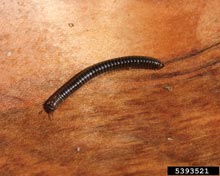
Whitney Crenshaw, Colorado State University

Gary Alpert, Harvard University
Millipedes & Centipedes
General Description
While millipedes don’t have a thousand legs as the name suggests, they do have two pairs of legs per body segment
distinguishing them from centipedes, which have one pair per segment. Both creatures typically have 30 or
more pairs of legs, are yellow-brown to black in color, and about an inch long. Most millipedes are
cylindrical, slow-moving plant-feeding creatures that can curl up and release foul-smelling secretions when disturbed.
centipedes have flattened bodies and typically move faster. One species, the house centipede (Scutigera
coleoptrata), is an exceptionally long-legged fast-running predator of insects and spiders. Centipedes also possess
appendages capable of injecting venom into their prey, like the fangs of spiders. While most centipedes are
too small to penetrate human skin, the house centipede, as well as larger desert and tropical species
scolopendra spp., can inflict wounds similar to bee stings. Both millipedes and centipedes live in damp places
such as under rocks, logs, leaves and mulch. When conditions aren’t suitable in the wooded areas where they
are abundant, millipedes sometimes embark on mass migrations and enter homes in large numbers. They enter
in search of moisture, food and shelter. But like sowbugs and pillbugs, they often die indoors because moisture
and food sources are insufficient. In contrast, the house centipede can live and reproduce in moist basements,
cellars, crawlspaces and bathrooms where spider and insect prey are plentiful.
General Control
Exclude these multi-legged pests by inspecting and sealing foundation cracks. For centipedes, it can be
beneficial to control the spiders and insects they feed on. Moisture control indoors and around the foundation is
also important in controlling these and other occasional invaders.









